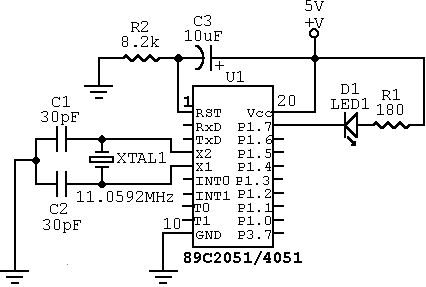
/************************************************ * example of using WHILE loop construct * * to drive 8 LEDS connected to port B * * * * * Compiler : MIDE-51 * * ************************************************/
#include < at89s51.h > /* Include 89s51 header file */ char const num[ ] = {0x01, 0x02, 0x04, 0x08, 0x10, 0x20, 0x40, 0x80};
void wait (void) { ; /* wait function */ }
void main( void ) { unsigned int i; unsigned char j;
P0 = 0; /* initialize ZERO to P0 */
while(1){
for( j = 0; j < 8; j++ ) { P0 = num[ j ]; for ( i = 0; i < 10000; i++ ) { wait(); /* delay for half second */ } } } }
Makes LED blink every 0.5 second
C Programming 8051
Wichit Sirichote, [email protected]
A basic circuit of the 89C2051 shown here can be made easily using point-to-point soldering with a universal PCB. Use an ordinary 20-pin socket, do not use a circle-pin socket. D1 is a small dot LED. U2 can be either 7805 or 78L05. U3 is optional for correcting any polarity DC adapter. Without the 2051 chip in the socket, checks the connection, then measures +5V between pin 20 and pin 10. Test the LED by shorting P1.7 pin to GND.

Test your board with myfirst.c, a simple c program that makes LED blink every 0.5 second.
/* * myfirst.c * First C program for 2051 experiment * complement P1.7 every 0.5 sec * Copyright (C) 1999 Wichit Sirichote * compiled with Dunfield Micro-C for 8051 Release 3.2 */
#include c:mc8051io.h /* include i/o header file */ #include c:mc8051reg.h
extern register char cputick; // cputick was incremented every 10ms register unsigned char sec100,flag1;
#define n 50
task1(); // functions declarations task2();
main() { flag1 = 0; sec100 = 0; serinit(9600); // set timer0 to be 16 bit counter while(1){
while(cputick == 0) ; cputick = 0; task1(); task2(); } }
task1() // set bit 0 of flag1 every n*10ms { sec100++; // increment sec100 if (sec100 >= n) {sec100 = 0; // clear sec100 flag1 |= 0x01; // set bit 0 of flag1 } }
task2() { if ((flag1 & 0x01) != 0) // execute below if bit 0 of flag1 is set{ // P1 ^= 0x80; // exclusive or the latch bit 7 with 0x80 asm " CPL P1.7"; // complement P1.7 flag1 &= ~0x01; // clear bit 0 of flag1 } }